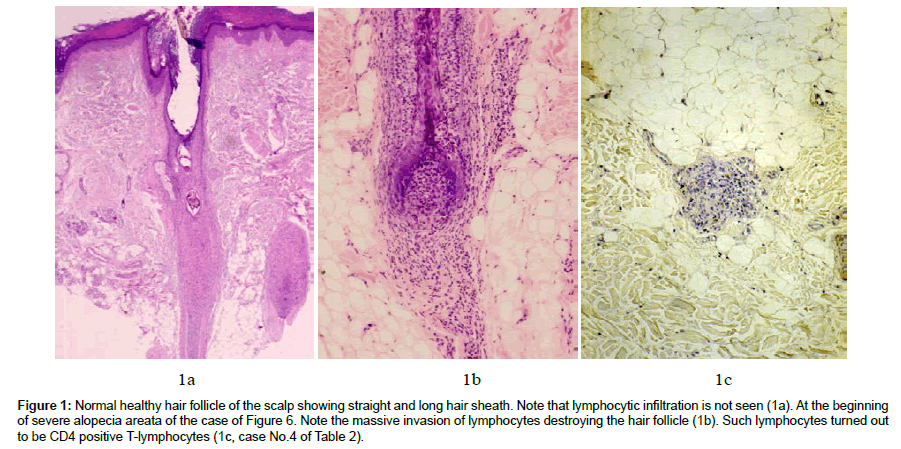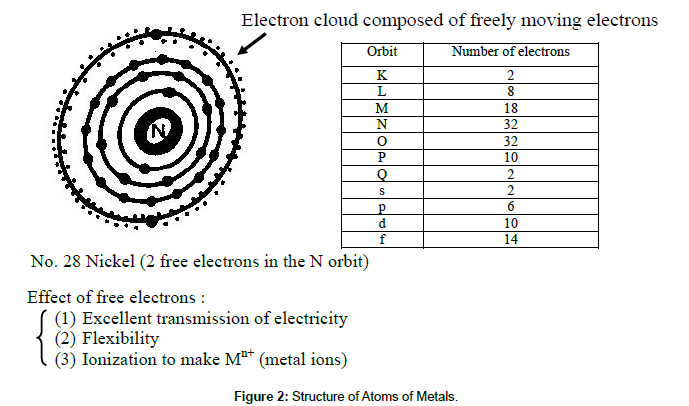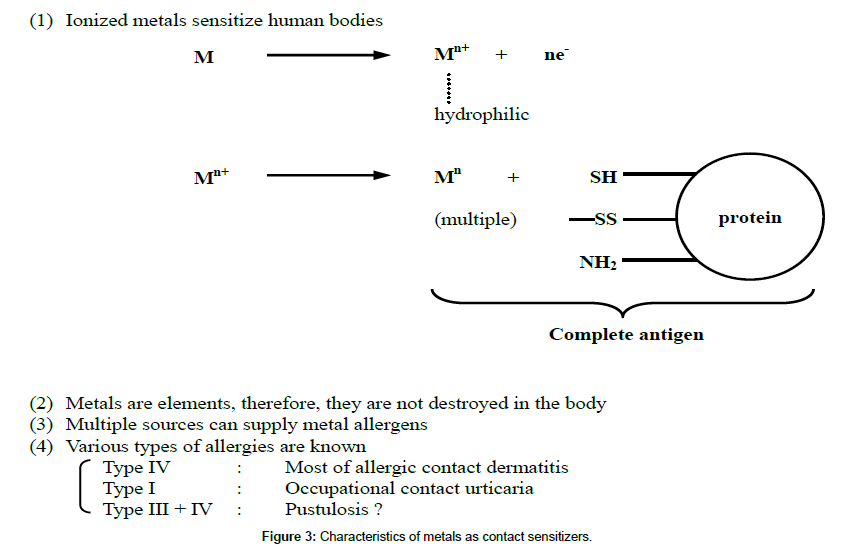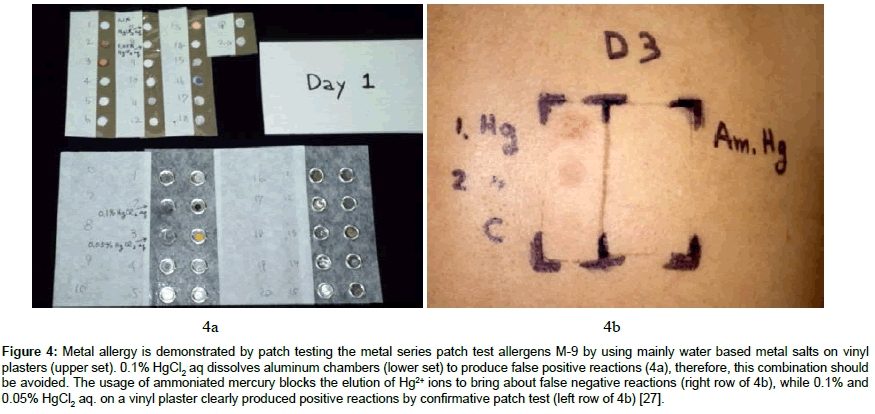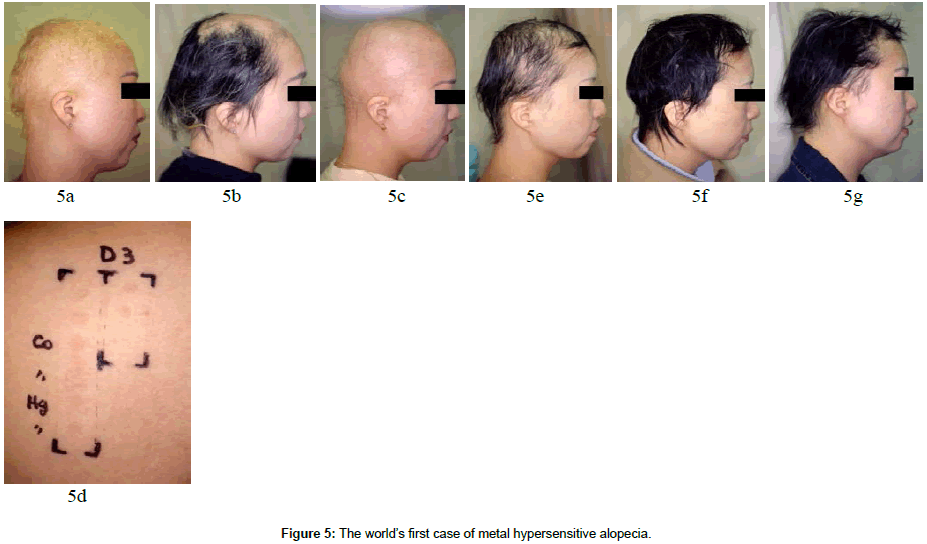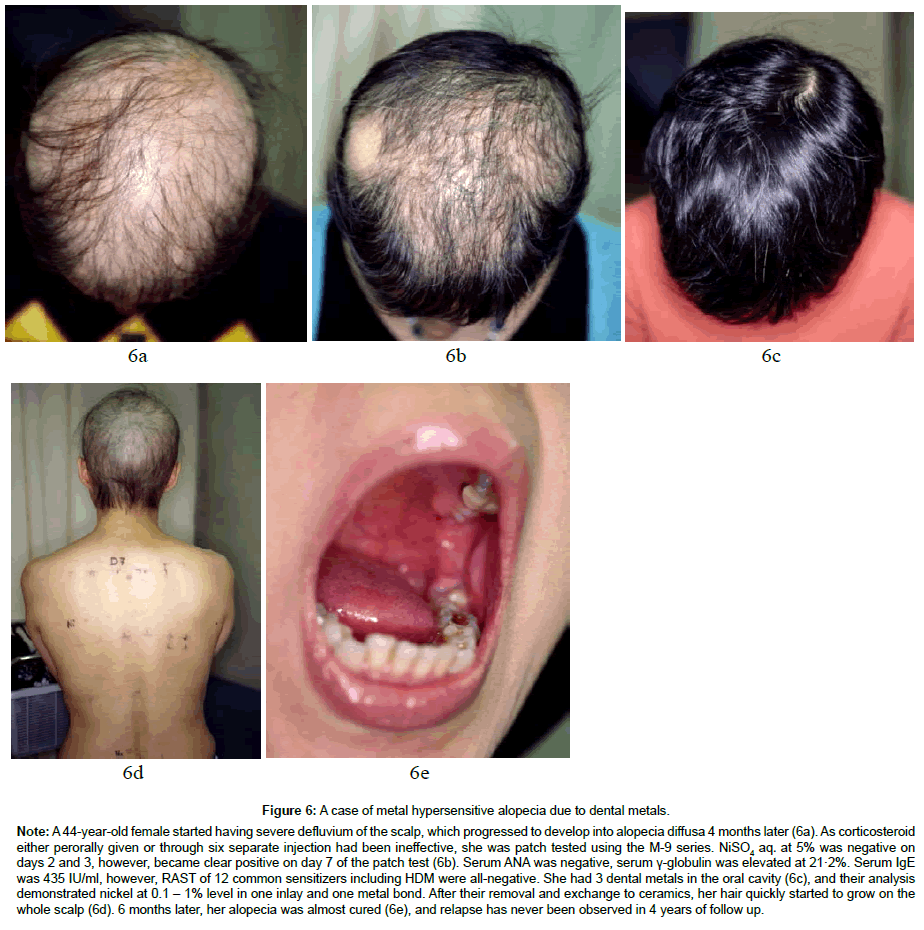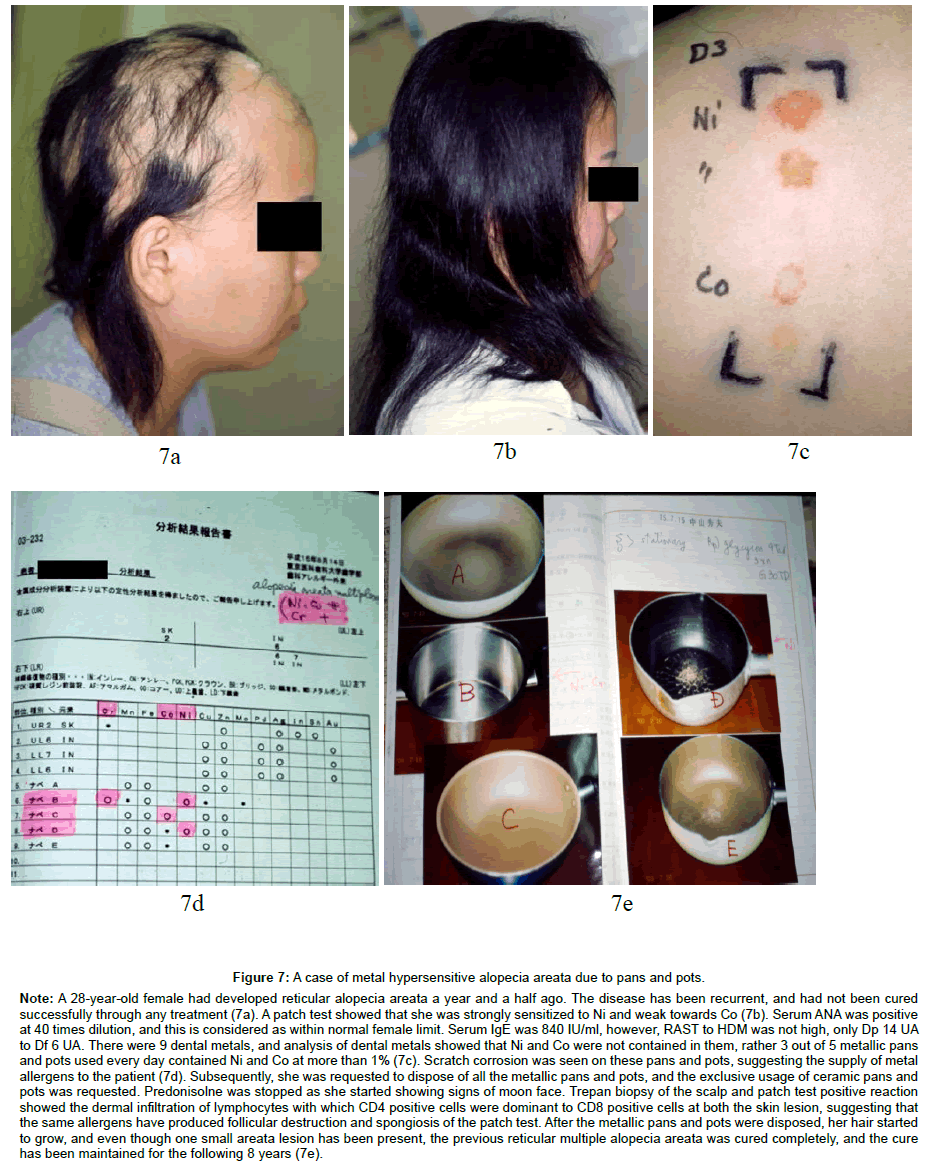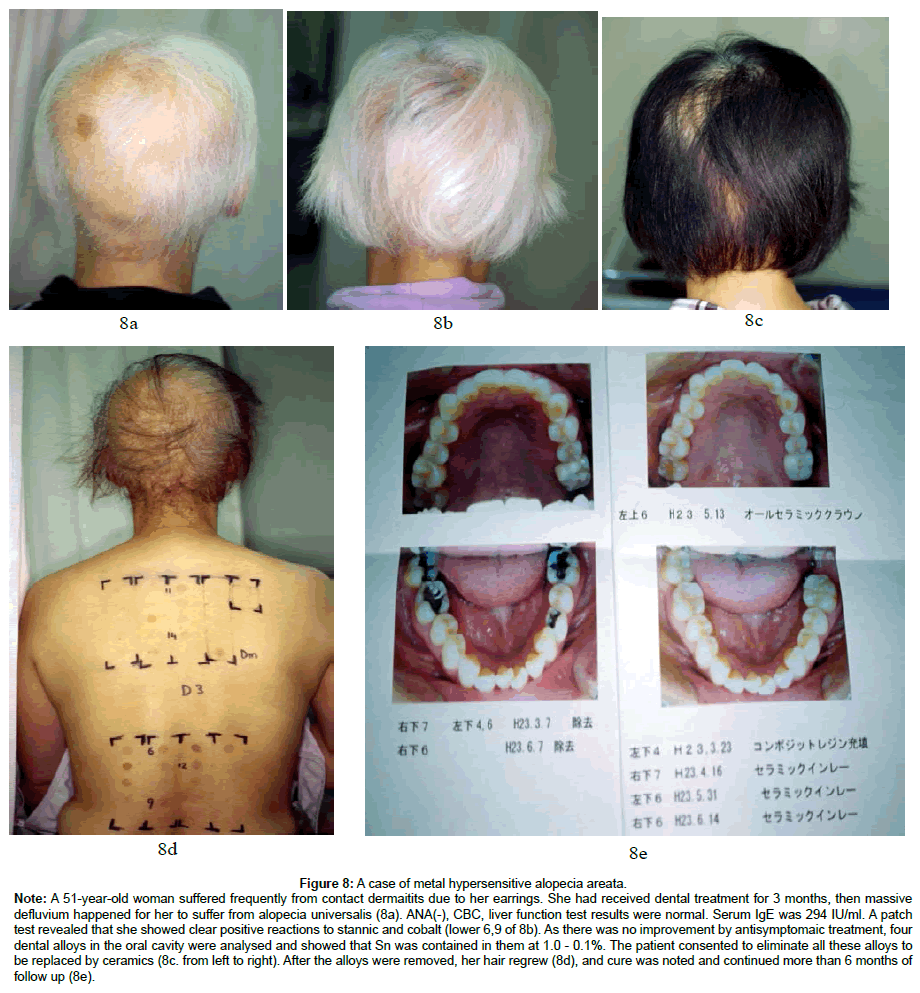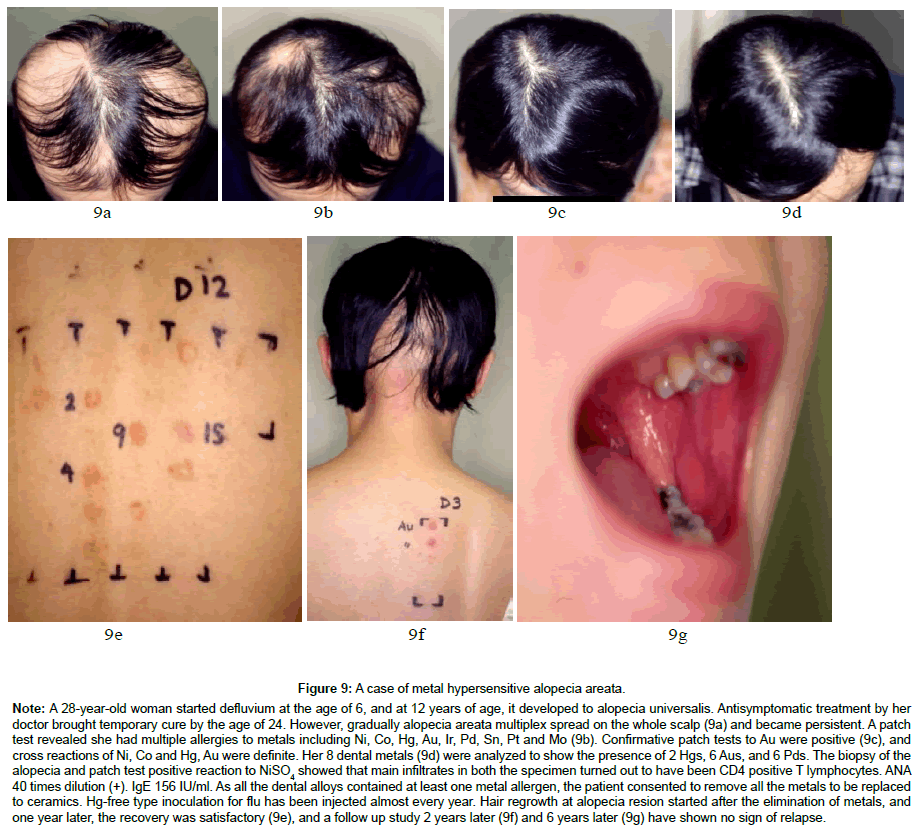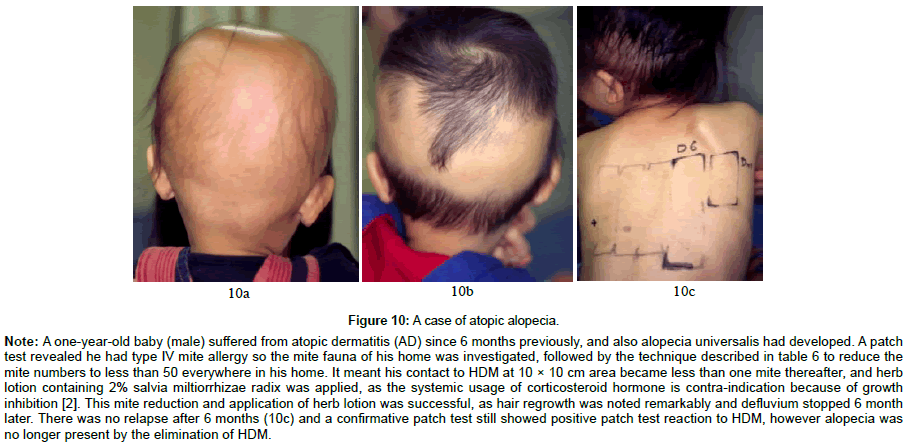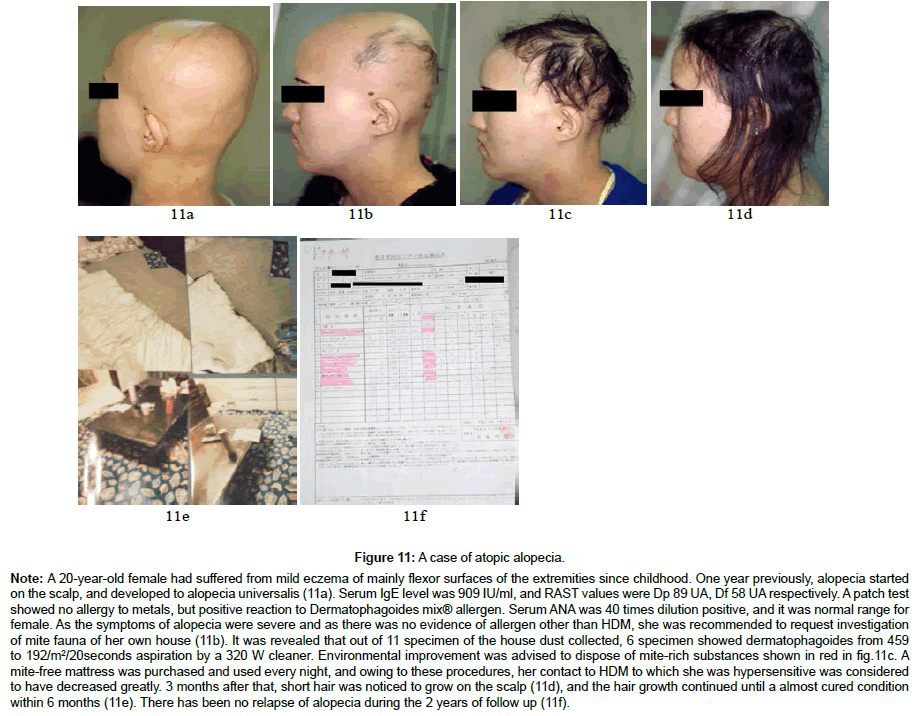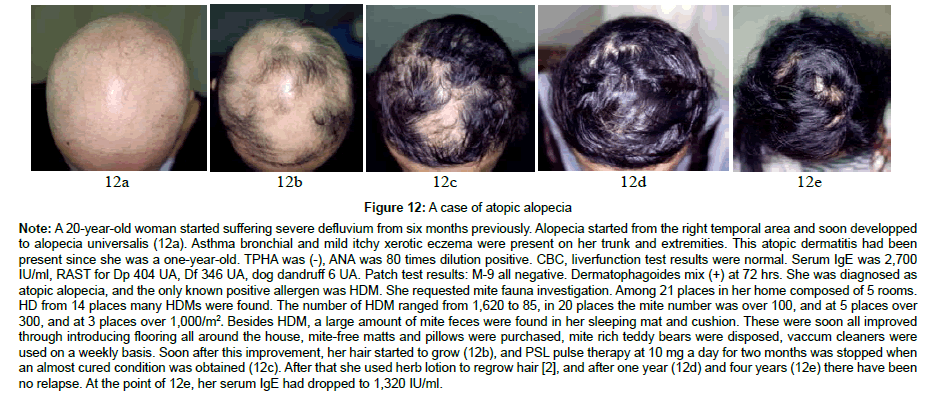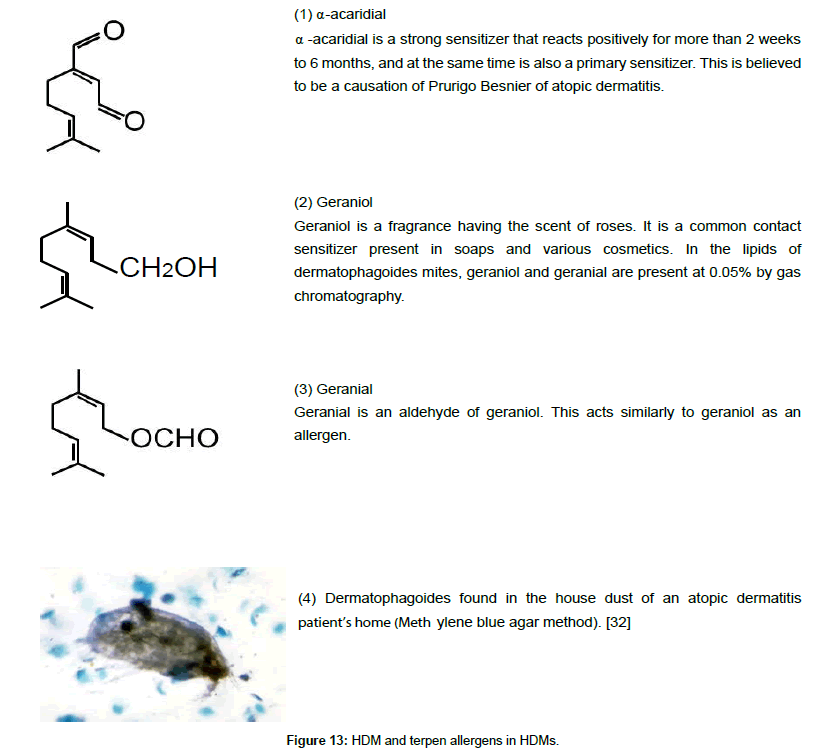Review Article, Clin Dermatol Res J Vol: 3 Issue: 1
How to Treat Metal Hypersensitive Alopecia Areata and Atopic Alopecia
Hideo Nakayama* and KoRon Chen
Meguro Chen Dermatology Clinic, Tokyo, Japan
*Corresponding Author : Hideo Nakayama
Meguro Chen Dermatology Clinic, Shinyo-CK Building 6F 3-3-5, Kami-Ohsaki, Shinagawa-ku, Tokyo 141-0021, Japan
Tel: +81-3-3786-1678
Fax: +81-3-3786-1515
E-mail: nakayamadermatology@eos.ocn.ne.jp
Received: December 12, 2017 Accepted: March 12, 2018 Published: March 15, 2018
Citation: Nakayama H, Chen K (2018) How to Treat Metal Hypersensitive Alopecia Areata and Atopic Alopecia. Clin Dermatol Res J 3:1. doi: 10.4172/2576-1439.1000125
Abstract
Metal allergy was found with severe types of alopecia areata (AA) at the rate of 69.9% and the elimination of metal allergens from dental metals, cooking instruments lead to satisfactory hair regrowth and prevention of severe relapse of AA for the period of in average four years and four months at the rate of 75.5%. The cooperation of dentists for analysis of dental metals, removing allergic alloys and replacing to ceramics were needed. Another causation of AA was type I and IV allergy to house dust mite (HDM). This type has been called atopic alopecia historically. There is enough evidence that HDM is the main causation of atopic dermatitis (AD). Severe and intractable AD could be cured by the mite fauna investigation by methylene blue agar (MBA) method, followed by environmental improvement to decrease mites to less than 50/m2 everywhere in the home. The same solution was applied to treat severe atopic alopecia cases, which were cured at the rate of 58.3%, and the longest record of confirmed period of cure was five years. When six years or more elapsed after the onset of AA, any kind of treatment was not successful, because biopsy of the scalp revealed the disappearance of hair follicles, which was replaced by dermal fibrosis. Therefore, the treatment of AA should start quickly, investigating allergy to metals and HDM.
Keywords: Alopecia areata; Metal allergy; Atopic alopecia; Atopic dermatitis; House dust mite (HDM)
Introduction
Alopecia areata (AA) is difficult to cure when it is a severe form such as the ones listed in Table 1. Histopathology of such cases show marked destruction of mostly the lower part of the hairfollicles, which are invaded by numerous lymphocytes which lead to massive hair loss (Figure 1). These lymphocytes are mainly CD4 positive T-cells, mingled with a smaller ratio of CD8 positive T-cells [1-7].
| 1. | Alopecia universaris |
| 2. | Alopecia totalis |
| 3. | Alopecia diffusa |
| 4. | Alopecia reticularis (alopecia areata multiplex confluens) |
| 5. | Alopecia areata, which has present for over 6 years or more. (Cases in which the hair follicles almost lost from scalp has replaced by fibrosis.) |
Table 1: Severe and intractable forms of Alopecia areata (AA).
Figure 1: Normal healthy hair follicle of the scalp showing straight and long hair sheath. Note that lymphocytic infiltration is not seen (1a). At the beginning of severe alopecia areata of the case of Figure 6. Note the massive invasion of lymphocytes destroying the hair follicle (1b). Such lymphocytes turned out to be CD4 positive T-lymphocytes (1c, case No.4 of Table 2).
Temporal hair regrowth is possible with severe AA by systemic perorally administered predonisolone (PSL) [8,9] or intramusculary injected triamcinolone acetonide of 40-50 mg once a month [10,11]. These two facts are evidences that AA is an allergic disease.
There are always causative allergens when there are chronic allergic diseases. The discovery and exact elimination of the causative allergens are essential treatment to completely cure intractable chronic allergic diseases. It has been so with various allergic contact dermatitis [12], bronchial asthma, urticaria [13], drug eruption, lichen planus [14-16], pustulosis palmaris et plantaris [12], and atopic dermatitis [17].
The causative allergens that provoke AA had not been known in the previous century, however, since the new millenium, metal allergy has gradually been recognized [14] (Table 2), and it has been clarified that mite allergy is the most crucial causation of atopic dermatitis (AD) [17-19]. The term atopic alopecia had been described by several authors already from the 1960s [20,21], however, as acarology had not been studied by a number of dermatologists, the responsibility of house dust imtes (HDM) in producing AD had been unnoticed for many years till today.
| S No. | Age & sex (F: female) | Onset of alopecia | Type of alopecia | Serum ANA | Serum IgE (IU/ml) | Patch test results | Result of metal analysis and electricity | Effect of removal of allergic metals | No. of Reference (Year) |
|---|---|---|---|---|---|---|---|---|---|
| 3 | 37F | 1.5 years | A. universalis | Titer 1:40 (+) | 210 | Ni(2+), Sn(2+) | Ni 85.9-9.9% in 6 dental metals | All 6 metals removed. Complete cure after one year. | 28 (2001) |
| 4 | 22F | 2 years | A. totalis | negative | <170 | Pd(2+), Pt(2+), Au(+) | All 6 dental metals contained Pd at 16.1-17.7% which were cathodes at 10-20 mV. | All 6 dental metals removed after which complete cure followed. | 14 (2002) |
| No relapse for the successive 3 years. | |||||||||
| 5 | 30F | 3 years | A. universalis | negative | 250 | Hg(2+), Au(2+) | 3 HgAms were present. | All 3 Hg Ams removed. | 29 (2004) |
| Hair regrowth soon started, complete cure 6 month later. | |||||||||
| For the next 9 months no relapse. | |||||||||
| 6 | 48F | 10 years (mild) 2 years (severe) (10 years previously dental metals were installed for the first time) |
A. diffusa | negative | 71 | Pd(2+), Pt(2+) | All 6 dental alloys contained Pd at 15.3-40.2% | All 6 dental alloys removed. | 30 (2006) |
| Hair growth followed soon to complete cure at 6 months. | |||||||||
| No relapse for the following 5 years. | |||||||||
| 7 | 21F | 10 months | A. diffusa | titer 1:40 (+) | 530 | Hg(2+) | 9 out of 13 dental metals were HgAms,which contained Hg at 43.3 – 55.0%. | All 9 HgAms were eliminated to have brought complete cure. | 31 (2012) |
| They were cathodes at 130 – 80 mV. | No relapse for one year after the elimination. | ||||||||
| 8 | 52F | More than three years | A. universalis | negative | 294 | Co(+); Sn(+) | 4 dental metals contained stannic. | All 4 Sn containing metals were removed to bring complete cure. | 31 (2012) |
Table 2: Severe alopecia cases in which metal allergy are the likely causation (cases No.3 – 8).
This is a report that two important allergens, metal ions, and with other cases, HDM are recognized as the causes of severe AA, and their exact elimination will often lead to a long lasting cure of this intractable disease.
Metal Allergy Makes a Wide Spectrum of Allergic Dermatitis
The chracteristics of metal allergy
Metals (M) do not sensitize people, however, when metals lose the outermost electrons to form metal ions (Mn+, Figure 2), they do not already have the appearance of hard metals, rather they are water soluble haptens, which have strong affinity to human epidermal and hair follucle protein, ie keratin, at the sites of -SS-, -SH and -NH2 (Figure 3) [14].
Keratin is our self component, therefore, it is not attacked by our own T-lymphocytes. Such self protection has been called immune privilege (IP) [22,23]. When metal ions meet keratin, either from outside of the body, or from inside of the body via blood streams when metal ions are taken from the mouth, then absorbed from the intestine, they produce complete antigen at the sites of keratin. Metal ions are elements, therefore, they are not destroyed either in the intestine or in the blood stream, and they act as haptens till they are expelled. Keratin is surely self, however keratin which conjugated metal ions are no longer self, in another word, an enemy substance to be attacked by one’s own T-lymphocytes. Such an alteration is considered as the “collapse of IP [23]”.
When metal ions come from the outside to the skins of those who are hypersensitive to Mn+, rejection reatction to Mn+ keratin is exerted at the sites of contact in the form of erythema, edema, papules with severe itching. It is an allergic contact dermatitis and ancient people called it “eczema”. When metal ions come from inside, the diseases provoked by it are pustulosis palmaris et plantaris, eczema dyshidrosiforme [12,14], oral and/or cutaneous lichen planus [14-16,24-26] and generalized eczema including pseudo-atopic dermatitis (Shanon) [24]. Evidence of their causation is normally shown by a metal series patch test, or a challenge test involving the ingestion of NiSO4 at 5 mg (as Ni2+, 1 mg). But when this challenge test was performed at 30 mg (as Ni2+, 6 mg) in one hospital, it provoked severe generalized dermatitis which had to be cured through hospitalization. Therefore, from ethical reasons, the challenge test should be done very carefully, only when it is indispensable to do so, in order to avoid medical claims.
Another characteristic of metal allergy is its unique cross hypersensitivity. For example, those who are sensitized to Ni2+, often react to Co2+, and those who are hypersensitive to Hg2+, often react to Au3+ [25]. Nickel and cobalt, and also mercury and gold are quite different metals to each other, however when they become Mn+, by losing their outermost electrons, Ni2+ and Co2+ become very much alike, because the only difference of these two are the number of electrons at 3d in M orbit which is 7 and 8 respectively, and all other numbers and arrangement of electrons are the same after ionization of these two metals. That is why simultaneous positive reactions are often observed by patch testing with NiSO4 and CoCl2 [14].
Likewise, when a patient is sensitized by gold, often due to earpiercing [25], the patch test reaction to AuCl3 is naturally positive, and at the same time, the patient shows a positive reaction to HgCl2. When ionized, the only difference between Au3+ and Hg2+ is that the numbers of electrons at 5d in 0 orbit are 8 and 10 respectively, while all other numbers and arrangements of electrons are completely the same [14]. This is why cross reactions occur frequently with Ni2+ and Co2+, and also with Au3+ and Hg2+. These cross reactions should be taken into consideration when causative metal allergens are to be eliminated for treatment for metal hypersensitive patients. The above mentioned cross reactions by the similarity of electron numbers and arrangements were previously reported [14].
When metal hypersensitiv alopecia areata was found
The discovery of the world’s first case of severe alopecia areata due to metal allergy was almost coincidental. The case with its symptoms and the course of cure is demonstrated in Figure 4. This case suggested that systemically invaded Hg2+ was the causative allergen for her alopecia, because regrown hair was quickly lost by the innoculation of influenza containing mercury at 47.6 μg, and recurrent and intractable severe alopecia areata for the past four years was completely cured with no relapse by the elimination of all the dental HgAms and avoidance of inoculation.
Figure 4: Metal allergy is demonstrated by patch testing the metal series patch test allergens M-9 by using mainly water based metal salts on vinyl plasters (upper set). 0.1% HgCl2 aq dissolves aluminum chambers (lower set) to produce false positive reactions (4a), therefore, this combination should be avoided. The usage of ammoniated mercury blocks the elution of Hg2+ ions to bring about false negative reactions (right row of 4b), while 0.1% and 0.05% HgCl2 aq. on a vinyl plaster clearly produced positive reactions by confirmative patch test (left row of 4b) [27].
The second case was a 24-year-old female suffering from alopecia diffusa for the past two months, which had been progressive and antisymptomatic treatment had been ineffective. Serum ANA and STS were negative, and serum IgE was in normal low range. Previously she suffered from allergic contact dermatitis due to metals, such as earring, necklaces etc. A patch test revealed that the contact allergen was nickel sulfate. In order to investigate the effect of systemically invaded Ni2+, she consented to a challenge test of having perorally adminstered 1mg of NiSO4 (0.2 mg as Ni2+) for 5 days successively for a total of 5 mg of NiSO4. Three days later, she revisited the hospital claiming that her defluvium of the scalp became progressive, and her area of alopecia had surely increased.
She was soon advised to stop the challenge test, and avoidance of Ni2+ started. As there had been no dental metals in the past, Ni2+ was considered to have come from the stainless steel pans and pots. Normally 18-8 stainless contained 18% chrome and 8% nickel. All of such pans and pots were requested to be changed to titanium or enamel coated pans and pots. After that the same antisymptomatic treatment composed of the application of herb lotions [2] brought almost cured conditions without any relapse.
From the third to eighth cases, they are listed in Table 2, and all of them were one by one reported in dermatological journals with photos in Japan and Europe (Croatia) [27-32].
Many cases followed
These initial cases strongly suggested the causation of metal ions on severe cases of alopecia areata. Therefore all the severe cases of alopecia areata were tested with a metal series patch test of M-9. Its results are demonstrated in Table 3, showing that the positive rates of every metal ions are very alike with alopecia areata (mild cases were excluded), contact dermatitis and atopic dermatitis. As metals are now common sensitizers in the world, the similarities of metal allergy in these three allergic diseases are understandable.
| Diseases | Alopecia areata (excluding mild cases) | Atopic dermatitis (AD) | Contact dermatitis | ||||||
|---|---|---|---|---|---|---|---|---|---|
| n | mean age | n | mean age | n | mean age | ||||
| Male | 27 | 36.4 | 71 | 36.7 | 71 | 46.3 | |||
| Female | 77 | 41.6 | 158 | 34.7 | 265 | 42.7 | |||
| subtotal | 104 | 40.3 | 229 | 35.3 | 336 | 43.5 | |||
| No. | Metal salts | % | base | positive (number) | Positive rate (%) | positive (number) | Positive rate (%) | positive (number) | Positive rate (%) |
| 1 | CuSO4 | 2 | Aq. | 9 | 8.7 | 28 | 12.3 | 33 | 9.8 |
| 2 | PdCl2 | 1 | Aq. | 8 | 7.7 | 8 | 3.5 | 33 | 9.8 |
| 3 | K2Cr2O7 | 0·4 | Aq. | 24 | 23.1 | 44 | 19.4 | 79 | 23.5 |
| 4 | NiSO4 | 5 | Aq. | 32 | 30.8 | 71 | 31.3 | 126 | 37.7 |
| 5 | NiSO4 | 2 | Aq. | 24 | 23.1 | 48 | 21.2 | 114 | 33.9 |
| 6 | CoCl2 | 2 | Aq. | 27 | 26.0 | 34 | 15.0 | 66 | 19.6 |
| 7 | HgCl2 | 0·1 | Aq. | 35 | 33.7 | 55 | 24.2 | 106 | 31.5 |
| 8 | HgCl2 | 0·05 | Aq. | 22 | 21.2 | 24 | 10.5 | 44 | 13.1 |
| 9 | SnCl4 | 1 | Aq. | 10 | 9.6 | 34 | 15.0 | 47 | 14.0 |
| 10 | CdSO4 | 1 | Aq. | 5 | 4.8 | 6 | 2.6 | 25 | 7.4 |
| 11 | HAuCl4 | 0·2 | Aq. | 8 | 7.7 | 10 | 4.4 | 36 | 10.7 |
| 12 | H2PtCl6 | 0·5 | Aq. | 14 | 13.5 | 24 | 10.5 | 42 | 12.5 |
| 13 | FeCl3 | 2 | Aq. | 3 | 2.9 | 3 | 1.3 | 9 | 2.7 |
| 14 | InCl3 | 1 | Aq. | 2 | 1.9 | 8 | 3.5 | 14 | 4.2 |
| 15 | IrCl4 | 1 | Aq. | 3 | 2.9 | 2 | 0.9 | 3 | 0.9 |
| 16 | MoCl5 | 1 | Aq. | 5 | 4.8 | 27 | 11.9 | 28 | 8.3 |
| 17 | AgBr | 2 | Pet. | 0 | 0.0 | 0 | 0.0 | 2 | 0.6 |
| 18 | SbCl3 | 1 | Pet. | 0 | 0.0 | 1 | 0.4 | 0 | 0.0 |
| 19 | ZnCl2 | 2 | Pet. | 12 | 11.5 | 8 | 3.5 | 22 | 6.5 |
| 20 | MnCl2 | 2 | Pet. | 3 | 2.9 | 7 | 3.1 | 2 | 0.6 |
Table 3: Patch test results of the M-9 series. A comparison of positive rates with three dermatoses for 5 years (Years: 2011-2015).
When metal allergy was clarified through a patch test, the positive cases to metal ions were examined to prove the multiple sources which had supplied metal ions to the patients. Table 4 shows the procedure, and dental metals were analysed by dentists capable of analysis using an electrone probe micro analyzer (EPMA) or X-ray fluorescence spectroscope (XRFS). All the causative metals with their cross reactors which showed positive reactions on a patch test were advised to be removed by the dentists. Substitutes were ceramics, titanium or the alloys of which components showed all negative reactions for the patients. Today a number of supplements and vitamins contain vitamin B12 (VB12), or cyanocobalamine, and as Co2+ often cross reacts to Ni2+, the ingestion of these cobalt containing supplements and vitamins were requested to be stopped.
| 1. | Perform a metal series patch test. The vehicle of NiSO4 and HgCl2 should be water on vinyl plaster with cloth or paper discs without using petrolatum, in order to avoid false negative reactions. The patch test should be performed for two days, and reactions should be read on the second, third (or fourth) and seventh (or sixth) days by ICDRG standards. (+) and (2+) are positive reactions. |
| 2. | When metal allergens are found, check the metals in the oral cavity. If present, request an analysis of these metals to a dental clinic where a metal analysis by electron probe micro analyzer (EPMA) or X-ray diffraction method is available. |
| 3. | The grade of electro-chemical dissolution of Mn+ in the oral cavity is measured by using an ammeter with two electrodes. The dissolution of Mn+ occurs at the dental metals as cathodes, in parallel with voltage and electric current (Faraday's law of electrolysis). Voltage and current is always parallel, therefore, only the measurement of voltage is necessary. When the mucous membrane is an anode with alloys cathode, Mn+ elutes from the cathode alloys. For example, HgAms are usually cathodes with a voltage of 100 - 200 mV to elute Hg2+ ions. |
| 4. | After the evidence of metal allergy is obtained and the analysis data exhibiting the presence of the patch test’s positive metals and their cross sensitizers is obtained, give the copy of these data to the patients, and explain that they suffer from metal allergy, and the causative metals are present in the oral cavity. When necessary, the electric current in the oral cavity is measured, and when cathode alloys contain metals to which the patients are hypersensitive towards, explain that the metal allergens elute from the dental alloys. |
| 5. | Explain to them that the complete removal of dental metals to which the patients are hypersensitive towards could cure their severe alopecia areata and inform them that past records show a 70% chance of being able to maintain a cured condition. Notify them that with only antisymptomatic treatment, they may be only be cured temporarily and that there is a 50% chance of relapsing to their original conditions. |
| 6. | Replace the metal pans and pots for cooking in the kitchen to non-metal pans and pots, such as ceramics, enamel-coated materials or strengthened glassware. Avoid having VB12 (cyanocobalamine) containing supplements, food and medication, when cobalt allergy is present. |
| 7. | Start anti-symptomatic treatment till enough hair regrowth has been obtained, making sure that excess usage of corticosteroid is avoided. The use of herb lotions will help the treatment [2]. |
| 8. | High cacao chocolates should be avoided as it contains Cr, Co and Ni higher than other food. |
| 9. | Inoculation of Hg / Thimerosal containing injectants should be avoided among Hg / Au hypersensitive patients. |
| 10. | Follow up the patients after recovery for at least for two years. |
| 11. | With those who are not allergic to any metal, the possibility of atopic alopecia or auto-immunity should also be considered. |
Table 4: Recommended investigation and treatment when metal allergy is found.
The metallic pans and pots were also analysed when necessary, and they were also replaced by ceramics, enamel coated ones and hard glass-ware.
Anti-symptomatic treatment was given as before, and when hypermenstruation, peptic ulcers, diabetes mellitus, young ages, chronic infection and osteoporosis were present, the usage of systemic corticosteroid was refrained [2]. The discovery and elimination of causative allergens like Mn+ aimed to stop the relapse of severe alopecia for the recovered patients to go back to the previous miserable skin conditions. Therefore after complete or almost complete recovery was noted, they were followed up as long as possible. The statistics show that the rate of improvement by the elimination of causative metals from the oral cavity and cooking instruments was 75.5% (37 out of 49), and the cure was maintained in average for 4 years and 4 months. This is considered satisfactory because all these cases could not have been cured previously for 2 years or more, and the rate of relapse after a satisfactory recovery through antisymptomatic treatment only was considered as being more than 50% [11]. Such procedure to eliminate causative allergen to prevent relapse and consequently maintain cured condition was previously called “allergen control” [12]. The typical successful cases are demonstrated in Figures 5-9.
Figure 6: A case of metal hypersensitive alopecia due to dental metals.
Figure 7: A case of metal hypersensitive alopecia areata due to pans and pots.
Figure 8: A case of metal hypersensitive alopecia areata.
Figure 9: A case of metal hypersensitive alopecia areata.
Treatment of atopic alopecia
The preliminary research performed in 1998 on 106 intractable alopecia areata confirmed the presence of atopic alopecia [3]. The rate of elevation of serum IgE at that time was 24.6% (16 out of 65 examined). When the severe alopecia areata patients showed negative patch test results to the M-9 series, and their serum IgE was high and xerotic eczema was noticed, they were considered as complicating atopic dermatitis (AD). Today the main causation of AD is considered as HDM allergy, as there is enough evidence for it shown in Table 5. Typical three cases of atopic alopecia who suffered from generalized eczema or prurigo Besnier for more than three years, hypersensitive to HDM, and cured by mite fauna examination, followed by environmental improvement to decrease mite number to less than 50/m2 everywhere in the house are demonstrated in Figures 10 and 12. With these cases, cure after mite elimination has lasted for an average of 2 years. Considering that these cases could not have been cured previously, the fact that cure was maintained for more than 2 years should be recognized as valuable.
| 1. | Serum IgE level is usually higher with AD compared to other atopic diseases, such as pure bronchial asthma, pure allergic rhinitis and pure urticaria. The average serum IgE with the latter three is 330 IU/ml, but with these three complicate eczema of AD, the average serum IgE levels goes over 1,000 IU/ml to 6,000 - 7,000 IU/ml. |
| 2. | 77 - 87% of serum IgE in AD was due to Dps when the factors that raise IgE were counted, eliminating cross reactions to similar allergens, such as Dp and Df, Malassezia and Pityrosporum. |
| 3. | Bruynzeel-Koomen discovered that IgE molecules present on dendric cells in the epidermis of AD react to airborne antigen and produce eczema. By this, type I allergy exerted by IgE is altered to type IV allergy of eczema. |
| 4. | When three live mites were crushed on slightly convex plastic discs of 8 mm in diameter, they produced clear positive eczematous reactions with AD patients, regardless of the value of serum IgE and RAST results. The reactions were all negative (0/18) with Df on controls, and there was statistical significance between the positive rate of AD (10/45=22.2%). An important phenomenon was that one crushed live mite or dead dry mites never produced positive reactions. It meant that when the mite numbers /m2 is less than 50, the patient lose contact to HDM, to escape from mite allergy. |
| 5. | Type IV allergy to HDM was discovered by Rawl in 1984 by experiment results that showed lymphocytes of AD reacted to mite allergen P1 at 50% of patients, while none of the controls reacted. |
| 6. | α-acaridial, a terpene discovered from HDM, is a primary sensitizer and considered as a causation of Prurigo Besnier. |
| 7. | When the mite fauna of AD patient's homes were investigated by the methylene blue agar (MBA) method, followed by an environmental improvement, severe intractable AD patients were cured completely at the rate of 70.6% (60/85) and the cure was maintained. Double blind tests have confirmed this fact. |
Table 5: Evidence that house dust mite allergy is the main causation of atopic dermatitis (AD) [32].
Figure 10: A case of atopic alopecia.
Figure 11: A case of atopic alopecia.
Figure 12: A case of atopic alopecia
HDM antigens are composed of protein, fecal and enzymic allergen (P1), several terpens including a strong and primary sensitizer, α-acaridial (Figure 13). Protein is impossible to reach the lower half of the open hair follicle, however, the other two are considered to be absorbed into the open hair follicle canal, because they are soluble to sebum excreted from the adipose glands.
When mite elimination was performed for the case Figure 13 could regrow hair and the cured condition remained for 4 years. There were similar 14 (58.3%) out of 24 cases, with whom the treatment described in table 6 was recommended. Such allergen control has been successful with many cases of AD since 1995 [17], but the similar experience on intractable atopic alopecia was the first report in 2017 [2].
| 1. | Serum IgE level with RAST on Dp and Df should be studied. When the results are normal, perform a patch test to HDM on Finn Chambers using Dermatophagoides mix® antigen (Chemotechnique Co, Sweden). |
| 2. | Even when serum IgE level is normal or low, and the IgE RAST for Dps and Dfs is negative, such cases are not the so-called intrinsic AD, but the possibility of type IV allergy to HDM is high. It can be demonstrated by a patch test using the Dermatophagoides mix®. This patch test should has be performed for 2 days, and the reactions should be read on days 2, 3 and 7, because a late phase positive reaction is quite common. |
| 3. | When type I or IV allergy to HDM is discovered, somebody (if possible, an astrologist) should visit the AD patient's home with a vacuum cleaner and small paper bags to be put in the duct, so that they can collect house dusts of the patient's home from 10 - 15 places for 1m2 for 20 seconds. Sleeping mats, pillows, bed mat, carpets, sofas, chairs, rags are important with which mite fauna should has be investigated. |
| 4. | House dusts should measure with weight (x mg), and 50 mg of it is put into a petri dish, and then melted 0.01% methylene blue containing agar at 4 ml is poured into it. After it becomes solid at room temperature, counting the mites (y) in 50 mg of house dust at one place is possible. The actual number of house dust is xy/50/m2. |
| 5. | Statistically, 90% of HDM are Dp or Df, to which the patients are hypersensitive towards. |
| 6. | Start environmental improvement to decrease house dust mites to less than 50/m2 everywhere. If this has attained, the improvement of AD on skin and atopic alopecia could has be expected. |
| 7. | If in some places the improvement has ignored, for example, by not to using mite-free mattress or mite-rich carpets and rags are not disposed, the improvement of severe AD or atopic alopecia is not to be expected. |
| 8. | Flooring all the interior of the house has most recommended, along with the usage of mite-free sleeping mats. In cold climates, the introduction of heater flooring has recommended. |
Table 6: Necessary mite fauna investigation and the methods of mite elimination in order to achieve less than 50/m2 everywhere in the house for patients with severe intractable atopic alopecia.
Autoimmunity should be studied further
Before the hypersensitivity to metals and HDM was known, autoimmunity had been believed to be the main causation of severe cares of alopecia areata [5,6]. With a previous study on 106 cases of severe alopecia areata, serum ANA positive cases were 9 (31.0%) out of 29 cases studied [3]. At that time it was reported that among these 9 cases, 3 cases (10.3%) who showed ANA positive at 160 times serum dilution were considered to be due to autoimmunity, because the laboratory which examined ANA (SRL company, Tokyo) reported that with females 64 (10.5%) out of 593 controls who did not suffer from any autoimmune diseases showed ANA positive at 40 to 80 times dilution. Therefore, with alopecia areata cases, ANA positive at 40-80 times dilution does not mean autoimmunity, and if being ANA positive at 160-320 times serum dilution is a sign of autoimmunity, about 10% of severe alopecia areata should be considered as auto immunity.
An experimental animal model of alopecia was made using human alopecia skin transplanted to mice or rats, and the exserted T-lymphocytes to have produced alopecia was CD8 (+) and NKG 2D positive T-lymphocytes, different from human alopecia which is caused by CD4 (+) and CD8 (+) T-lymphocytes. Human hairfollicle components are self to human, but non-self to mice or rats, therefore this type of experimental alopecia is not an auto-immune reaction. Using normal human hairfollicle components to find out what components produce autoimmune allergy was once planned, but not accepted to be performed in an university from ethycal reasons. Therefore this is still a problem to be investigated in the future.
Conclusions
Severe types of alopecia areata (AA) are difficult to cure, because even it has been known to be an allergic disease, yet the causative allergens have not been detected. Autoimmunity was most suspected as a causation, but what exact component of human hair follicles produced autoimmunity has been obscure. After the new millennium, metal allergy was found in AA at 69.9%, and also the analysis of dental metals and cooking instruments followed by the elimination of allergenic metals with substitutes by ceramics showed the evidence of cure for a long period. Immune privilege (IP) of keratin is surely broken, when metals perorally taken, absorbed from intestine and carried to hair follicle keratin via blood stream make complete antigen of metal-combined keratin. Antisymptomatic treatment only produced severe alopecia again more than 50%, but the allergen control on metals could maintain the cured condition of AA at 75.5% in average for 4 years and 4 months (Table 7).
| Metal hypersensitive alopecia areata | |
|---|---|
| Patch test positive to metals | 102/146 = 69.9% |
| Rate of improvement after elimination of metals from oral cavity and or pans and pots (Cure continued for 2 to 12 years for an average of 4 years, and 4 months) |
37/49 = 75.5% |
| Atopic alopecia | |
| serum IgE > 250 IU/ml | 29/64 = 45.3% |
| Rate of improvement after environmental improvement | 14/24 = 58·3% |
| Alopecia presumably due to autoimmunity | |
| serum ANA positive (at 1:160 ~ 1:320 dilution)* | 3/70 = 4.3% |
| Rate of improvement only through anti-symptomatic treatment | 0/3 = 0.0% |
Table 7: The rate of satisfactory improvement of severe alopecia areata with which hair regrowth was noted over more than 70% of the scalp (Years 1996-2015).
Another type of AA has been called atopic alopecia, and most of the cases are not sensitized by metal, but they are sensitized by house dust mites (HDM). Type I and IV allergies to HDM exist. Severe types of atopic alopecia could be cured by the mite fauna investigation of the patient’s homes by the MBA method, followed by an environmental improvement to reduce mite numbers to less than 50/m2, because the patients could lose contact to HDM at less than 1 or 0 at 10×10 cm2 everywhere. These cases regained hair at 58.3%, even though their previous symptoms were severe. When 6 years or more elapsed since the onset, and curing was found to be very difficult, because the biopsy of such cases revealed that hairfollicles were not present, leaving small debris fragments with surrounding fibrosis. AA should be examined for the allergens of metals and HDM, and should be treated by allergen control / allergen elimination before allergic reactions devastate precious hair follicles in wide areas.
References
- Ioffreda, MD (2015) Alopecia areata, Lever’s Histopathology of skin (11th Edtn) Wolters Kluwer, NY: 545-595.
- Nakayama H, Chen KR (2017) Herb lotions to regrow Hair in patients with intractable alopecia areata Clin Med Invest 2: 1-7.
- Koizumi M, Nakayama H. Ebihara T (1998) Laboratory test results and the effect of treatment in 106 cases of intractable alopecia areata. Jap J Dermatol 108: 1881-1891.
- Gilhar A, Landau M, Assy B, Sharaginov R, Serafimovich MS, et al. (2002) Mediation of alopecia areata by cooperation between CD4+ and CD8+ T lymphocytes: transfer to human scalp explants on Prkdc (scid) mice. Arch Dermatol 138: 916-922.
- Tobin DJ, Orentreich N, Fenton DA, Bystryn JC (1994) Antibodies to hair follicles in alopecia areata. J Invest Dermatol 102: 721-724.
- Tobin DJ, Hann SK, Song MS, Bystryn JC (1997) Hair follicle structures targeted by antibodies in patients with alopecia areata. Arch Dermatol 133: 57-61.
- McElwee KJ, Freyschmidt-Paul P, Hoffmann R, Kissling S, Hummel S, et al. (2005) Transfer of CD8(+) cells induces localized hair loss whereas CD4(+)/CD25(-) cells promote systemic alopecia areata and CD4(+)/CD25(+) cells blockade disease onset in the C3H/HeJ mouse model. J Invest Dermatol 124: 947-957.
- Kern F, Hoffman WH, Hambrick GW Jr, Blizzard RM (1973) Alopecia areata, Immunologic studies and treatment with prednisone. Arch Dermatol 107: 407-412
- Winter RJ, Kern F, Blizzard RM (1976) Predonisolone therapy for alopecia areata. Arch Dermatol 112: 1549-1552.
- Michalowski R, Kuczyńska L (1978) Long-term intramuscular triamcinolon-acetonide therapy in alopecia areata totalis and universalis. Arch Dermatol Res 261: 73-76.
- Kurosawa M, Nakagawa S, Mizuashi M, Sasaki Y, Kawamura M, et al. (2006) A comparison of the efficacy, relapse rate and side effects among three modalities of systemic corticosteroid therapy for alopecia areata. Dermatology 212: 361-365.
- Nakayama H, Nogi N, Kasahara N, Matsuo S (1990) Allergen control. An indispensable treatment for allergic contact dermatitis. Dermatol Clin 8: 197-204.
- Turjanmaa K (1997) Contact Urticaria from Latex Gloves, Contact Urticaria Syndrome. CRC Press, NY: 173-187
- Nakayama H (2002) New aspects of metal allergy. Acta Dermatovenerol Croat 10: 207-219.
- Finne KAJ, Goransson K, Winckler L (1982) Oral lichen planus and contact allergy to mercury. Int J Oral Surg 11, 236-239.
- Stenman E, Bergman M (1989) Hypersensitivity reactions to dental materials in a referred group of patients. Scand J Dent Res 97: 76-83.
- Nakayama H (1995) The role of house dust mite in atopic eczema, Practical Contact Dermatitis. Mc Grawhill, NY: 623-630
- Seidenari S, Manzini BM, Danese P, Giannetti A (1992) Positive patch tests to whole mite culture and purified mite extracts in patients with atopic dermatitis, asthma, and rhinitis. Ann Allergy 69: 201-206.
- Tanaka Y, Takenaka M, Matsunaga Y, Okada S, Anan S, et al.(1995) High affinity IgE receptor (Fc epsilon RI) expression on eosinophils infiltrating the lesions and mite patch tested sites in atopic dermatitis. Arch Dermatol Res 287: 712-717.
- Ikeda T (1965) A new classification of alopecia areata. Dermatologica 131: 421-445.
- Katsuoka K, Arai A, Kameyama K, Noguchi T, Nishiyama S (1992) Atopic alopecia areata, Hifubyo-Shinryo. Dermatosis Treat 14: 729-733.
- Guo H, Cheng Y, Shapiro J, McElwee K (2012) The role of lymphocytes in the development and treatment of alopecia areata. Expert Rev Clin Immunol 11: 1335-1351.
- Paus R, Bertolini M (2013) The role of hair follicle immune privilege collapse in alopecia areata: status and perspectives. J Investig Dermatol Symp Proc 16: s25-s27.
- Shanon J (1965) Pseudo-atopic dermatitis. Contact dermatitis due to chrome sensitivity simulating atopic dermatitis. Dermatologica 131: 176-190.
- Nakada T, Iijima M, Nakayama H, Maibach HI (1997) Rôle of ear piercing in metal allergic contact dermatitis. Contact Dermatitis 36: 233-236.
- Fleischman P (1928) Zur Frage der Gefährlichkeit Kleinster Quecksilber Mengen. Dtsch Med Wochenscher: 304.
- Kubo Y, Nonaka S, Yoshida H (1992) False positive reaction to patch testing with aqueous mercuric chloride in an aluminum Finn Chamber. Contact Dermatitis 26: 136-137.
- Nakayama H (2001) The effect of long term administration of glycyrrhizin plus application of herbal lotion on intractable cases of alopecia areata, Nishi-Nichi Hifu (West Japan Derma) 63: 191-196.
- Nakayama H (2004) Metal allergy, Hifu To Biyou (Skin and Cosmetic Treatment). 36: 124-132.
- Nakayama H (2006) Dental Metal Allergy. J Environ Dermat 13: 37-65.
- Nakayama H, Kumei A (2012) A new disease due to metal allergy –metal hypersensitive alopecia. Allergy no Rinsho (The Allergy in Practice) 432: 697-702.
- Nakayama H, Kumei A, Chen KR, Takaoka M (2018) Mite Fauna Investiation Followed by Environmental Improvement Is Essenetial In Treating Intractable Atopic Dermatitis. Clin Med Invest 3: 1-13.
 Spanish
Spanish  Chinese
Chinese  Russian
Russian  German
German  French
French  Japanese
Japanese  Portuguese
Portuguese  Hindi
Hindi 